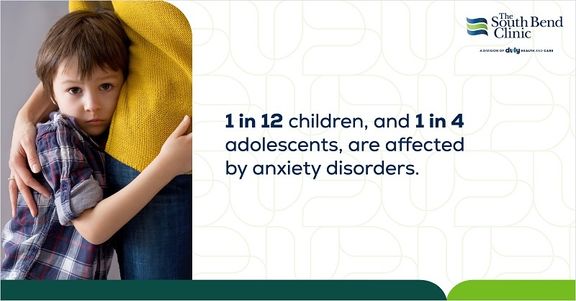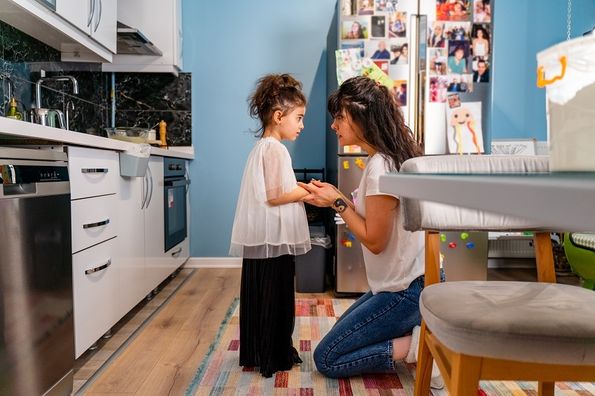Sweaty palms before speaking to a crowd, feeling overwhelmed by a mounting pile of work, worrying that your friends are silently judging you for that awkward fashion faux pas you made last week…feeling anxious every once in a while is a normal part of life.
But when anxiety is constant and starts to take over daily life, it could be a sign of an anxiety disorder. In fact, it’s the most common psychiatric condition among children and adolescents.
Anxiety can start at any age. Even young children, who you might feel have nothing to worry about, can experience anxiety. However, it’s not always easy to spot anxiety in children, especially when they are very young. They might not have the words to express how they feel. Anxiety also can be tricky to notice from the outside since the symptoms can look a little different in children.
Remember, some anxiety is normal, such as “stranger danger” and worrying about an upcoming test or performance. However, if the anxiety negatively impacts daily functioning, such as refusing to go to school because there is a test coming up or avoiding engaging in sports or other activities for fear of being watched during games or performances, there might be something more going on. Talking to your child’s primary care provider can help differentiate whether the anxiety is expected in a certain circumstance or if it is causing problems in functioning and might require further evaluation and/or treatment.

Here are 5 things to know about anxiety in children.
1. There Are Several Types of Anxiety.
“Anxiety” is a blanket term – there are a few different types of disorders under the anxiety umbrella. Adults can have some of these disorders, too.
- Generalized anxiety disorder (GAD) consists of excessive fear about things that happen in everyday life or a constant feeling of being overwhelmed. The anxiety isn’t always about one thing in particular – it’s usually a wide range of things, such as school/grades, relationships, current events, the weather, or safety.
- Social anxiety disorder (social phobia) is an intense fear of being embarrassed in social situations or being judged by others. Children with social anxiety disorder are often overly self-conscious.
- Specific phobias are extreme fears about something in particular, often to the point of going out of one’s way to avoid the object of that fear. These fears are more severe than they should be – the thing your child is afraid of likely isn’t as dangerous as they think it is.
- Panic disorder consists of unprovoked episodes of intense anxiety with predominantly physical symptoms, such as heart racing, difficulty catching one’s breath, sweating, and shaking, coupled with the feeling of impending doom.
- Separation anxiety disorder is when someone has anxiety and fear when they’re separated from a certain person that’s so strong that it interferes with everyday life. For example, a child may cling to their parent or hide in the back of the car to avoid going to school.
Read on Duly Health and Care: Caring for Your Child’s Mental Health
2. Separation Anxiety Disorder Can Happen in Older Children, Too.
It’s normal for babies and young children to experience separation anxiety when they aren’t with their parent or caregiver. Most children grow out of this by the time they are 3 years old. If separation anxiety continues, it could be separation anxiety disorder.
Separation anxiety disorder can continue throughout childhood and into adolescence and teenage years. Your child may worry excessively that something bad will happen to a loved one while they’re away or avoid going to school because they’re afraid of being separated. If they are in their adolescent or teen years, they may become dizzy or have heart palpitations when they are (or anticipate being) apart.
3. Symptoms of Anxiety in Children Might Be Different Than You Would Expect.
There are certain symptoms that happen across all ages, like feeling nervous or tense. Others, like throwing tantrums or crying in social situations, are more common in children.
Many symptoms, like shaking, sweating, or having heart palpitations in intimidating situations, are well-known signs of anxiety. Others aren’t so obvious. Look out for physical, behavioral, and emotional signs.
Physical symptoms
- Headaches or upset stomach for no medical reason
- Difficulty falling or staying asleep
- Restlessness, hyperactivity, or constantly being distracted
- Never feeling hungry or feeling hungry all the time
Behavioral symptoms
- Not participating in class activities like circle time
- Sitting by themselves at lunch or recess
- Refusing to go to school
- Tantrums
- Frequently saying, “I can’t do it,” for no reason
- Constantly asking “what if”-questions (like “What if it rains?”)
Emotional symptoms
- Constant crying
- Oversensitivity
- Fear of making mistakes
- Frequent nightmares about a loved one dying
- Worrying about the future while they’re still very young (e.g., a six-year-old being worried about finding a job after college)
- Grouchiness or anger for no reason
You probably don’t need to be worried if your child has these symptoms once in a while. They could simply be having a run of bad days. But if symptoms are severe, frequent, or interfere with how they function in day-to-day life, it’s time to bring them to a medical professional.
If you suspect that your child has anxiety, or they have already been diagnosed and need treatment, schedule an appointment with your child’s South Bend Clinic primary care provider to discuss your concerns. If appropriate, they may refer your child to a mental health provider.
Read on Duly Health and Care: How do I Know if I Have an Anxiety Disorder?
4. Childhood Anxiety Is Treatable.
There are two main types of treatment for children with anxiety, and the type your child needs often depends on the severity of their anxiety.
For mild and moderate anxiety, the most common treatment for children is cognitive behavioral therapy (CBT). During CBT, your child will learn about facing their fears, rather than avoiding them, in order to diminish the fear. Therapists can also help kids develop and improve social skills and teach relaxation techniques to help them cope when they get anxious. CBT isn’t usually ongoing. Your child’s therapist and insurance provider will help you determine the number of sessions.
When anxiety is severe, or if CBT isn’t enough, your child may also benefit from medication to treat anxiety. It’s usually recommended that children who take medication also do CBT – the treatments work best when they’re used together.
Unlike CBT, medications are more of a long-term treatment. That doesn’t necessarily mean that your child will be on them forever. Many children can stop taking medications when their symptoms have been in remission for at least 6 to 12 months. This should be discussed with your child’s prescribing provider – do not have your child stop medication without talking to their provider, first.
Also read: Daily Habits That Impact Mental Health and How to Improve Them
5. Don’t Assume That Your Child Will Grow Out of Anxiety.
Anxiety disorders can improve as children and adolescents grow and learn more coping strategies and/or move on from a stressful situation or environment. However, children who develop anxiety disorders are often at higher risk of having anxiety disorders as adults, even if the specific type of anxiety disorder changes. That’s why it’s important to recognize anxiety early if it is affecting their daily functioning in a negative way and get treatment if needed.
Health Topics:





